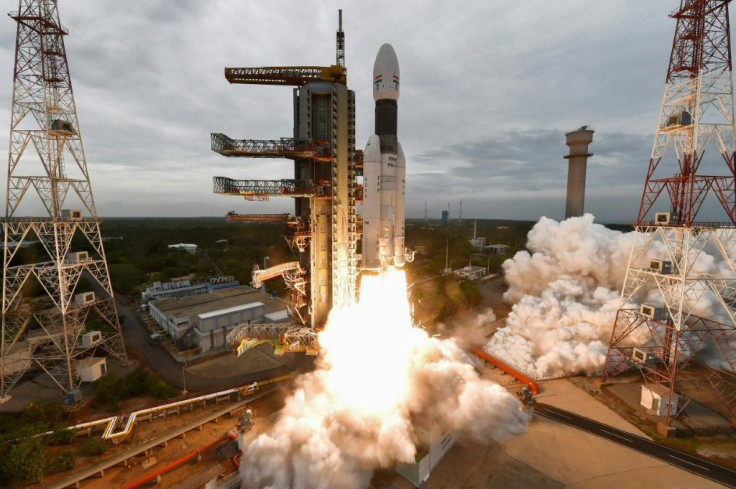India Planning Another Unmanned Moon Mission After Two Failures

KEY POINTS
- A lunar mission last September crashed on the moon’s surface
- India plans to launch a manned mission to the moon by 2021
- India wants to be the fourth nation to land a craft on the moon
The Indian Space Research Organization, or ISRO, said it will send a female humanoid robot named Vyommitra into space for its next unmanned mission to the moon.
Vyommitra can speak but “she” has no legs.
"It's called a half humanoid because it doesn't have legs," ISRO scientist Sam Dayal said. "It can only bend sidewards and forward. It will carry out certain experiments and will always remain in touch with the ISRO command center."
After two failures, including a lunar crash landing last September, ISRO is planning a third unmanned lunar mission -- Chandrayaan-3 -- slated for launch later this year. Chandrayaan is the Sanskrit word for “moon vehicle.”
"We are targeting the launch for this year, but it may spill over to next year," ISRO chairman Kailasavadivoo Sivan said.
Chandrayaan-3 will have a “similar configuration” as the prior mission, Sivan added. Chandrayaan-3 will have a lander and a rover, but not an orbiter, and will seek to confirm the presence of water in the form of lunar ice on the moon’s south pole, where no other lunar mission had ever attempted to go before.
Sivan said this unpiloted mission is expected to cost at least $35 million.
The failed Chandrayaan-2 mission in September was unable to put a rover on the lunar surface after a crash landing. That mission also tried to land on the south pole.
Jitendra Singh, junior minister for the department of space, said the new mission will be "quite economical.”
"The orbiter is already there. So we are going to be cutting cost," he told the Times of India.
Having learned from past mistakes, ISRO s cientists will conduct a simulation of the lunar landing sequence and will make certain that the brake thrust – which caused the lander to crash in an earlier mission -- is designed more effectively.
India wants to become the fourth nation to land a spacecraft on the moon's surface -- after Russia, the U.S. and China. In April 2019, Israel made an unsuccessful attempt to land a spacecraft on the moon.
Sivan also said India wants to send a manned mission to the moon in late 2021 and has already selected four candidate astronauts for that endeavor. Those four candidates will commence training in Russia. This project, called Gaganyaan, is expected to cost less than 100 billion rupees ($1.4 billion), the Indian government said in 2018.
The piloted mission will mark the 75th anniversary of India's independence from British rule.
India has developed a reputation for “affordable” space launches. Its unmanned mission to Mars in 2014 cost only $74 million.
India’s Prime Minister Narendra Modi is a huge supporter of the space program and was not discouraged by last year’s failed moon mission.
He said the moon program has “awakened and united the entire country” and that “an ISRO spirit is running in the country. Countrymen are not ready to accept negativity.”
However, some critics think that space missions are a waste of money when India has so many other pressing problems, like poverty and hunger.
“India ranks 103 among 119 countries on the global hunger index,” said Shah Fahad Azmi of Syamaprasad College, Calcutta. “Therefore, there should be more concern about the levels of poverty, education, health and sanitation, which are the basic needs of life that everyone has a right to. Instead of wasting money on overambitious space missions, we should concentrate on things more essential to improving the standard of living.”
Similarly, Eshaan Raj of St. Xavier’s School, Bokaro Steel City, Jharkhand, said India is facing issues that are of more concern than space missions, such as collapsing buildings and rapes. “The country is facing communal trouble with regular reports of lynching, making the common people feel miserable and unsafe,” Raj said. “But instead of addressing such serious problems, the government is more concerned about landing on the moon or dancing in space. India is a democracy and her people should be the first and foremost concern of the government, not overambitious space missions which require [billions] of rupees that can be better spent elsewhere.”
Eshika Gupta of Carmel Junior College, Jamshedpur, Jharkhand, lamented that many people in India suffer from poverty. “Some do not even have sufficient money to buy their daily bread and the government, instead of improving their living conditions, is wasting money on space missions,” Gupta said. “First, we have to make sure our country has developed -- socially, culturally and economically -- before indulging in these activities.”
© Copyright IBTimes 2024. All rights reserved.





















